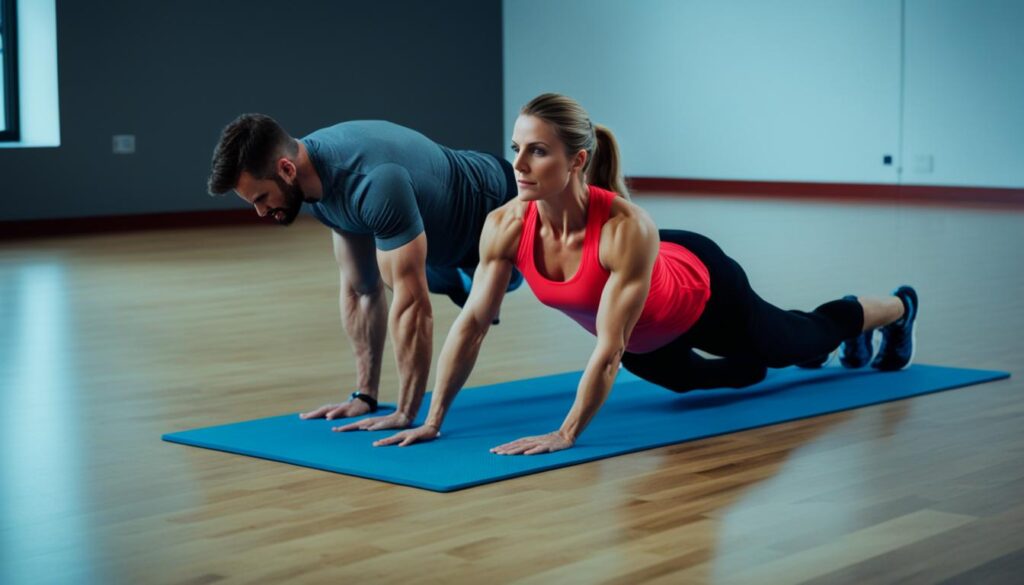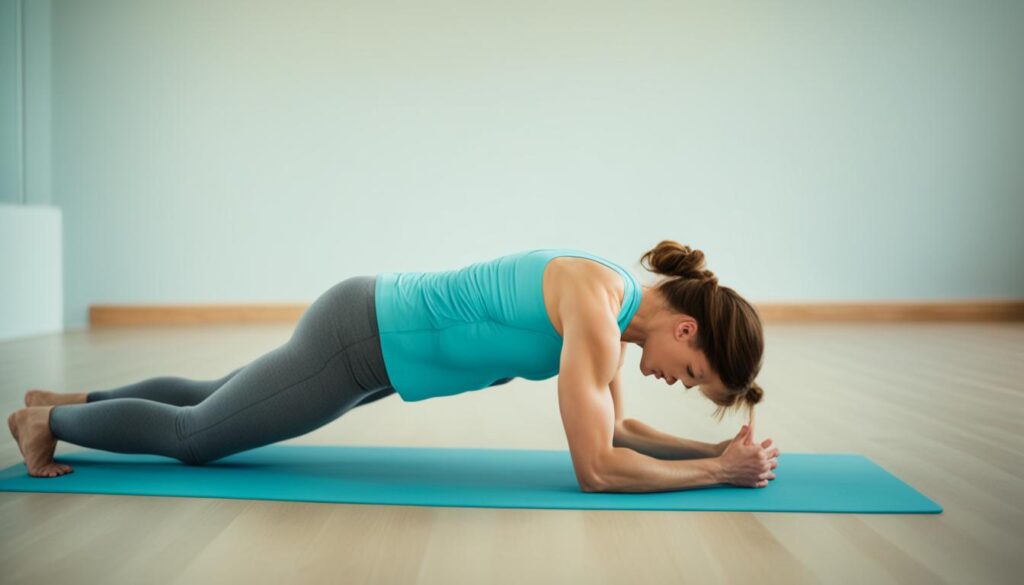Are you tired of struggling with back pain and a weak midsection? Looking for an exercise that can help you strengthen your core and improve your overall stability?
Look no further! In this article, we will reveal the top exercise that effectively strengthens your midsection and back, giving you the strong and stable core you’ve always wanted.
Strengthening the midsection and back is not only beneficial for aesthetic purposes but also crucial for maintaining a healthy spine, improving posture, and preventing injuries. By targeting these muscles, you can enhance your overall athletic performance and conquer daily activities with ease.
So, what is this magical exercise that promises to transform your core? Join us as we explore the power of core strengthening exercises and reveal the secret to a strong midsection and back.
Key Takeaways:
- Strengthening the midsection and back is essential for overall stability and strength.
- A strong core improves posture, prevents injury, and enhances performance.
- The top exercise for strengthening the midsection and back will be unveiled.
- Core strengthening exercises provide a comprehensive workout for multiple muscle groups.
- By incorporating this exercise into your routine, you can achieve a strong and stable core.
Understanding Core Stability and Its Importance

Core stability is the key to a strong and stable midsection. It involves the activation of deep abdominal muscles, back muscles, and muscles around the pelvis, all working together to provide support and stability to your spine and pelvis. Achieving core stability is not only about having a toned six-pack; it goes beyond aesthetics. It is about building a solid foundation for improved posture, balance, and coordination.
But why is core stability so important? Well, let me tell you, it’s not just about looking good at the beach. Core stability plays a crucial role in everyday life and athletic performance. Let me break it down for you:
- Proper Posture: Core stability helps maintain proper spinal alignment, reducing the risk of slouching and promoting good posture. By keeping your core muscles engaged, you can prevent excessive strain on your back and maintain a healthy spinal curve.
- Improved Balance and Coordination: Having a stable core provides a solid base of support, enhancing your balance and coordination. This is especially important for athletes involved in activities that require quick and precise movements.
- Prevention of Lower Back Pain: Weak core muscles can lead to instability in the spine, which may result in lower back pain. By strengthening your core, you can alleviate stress on your lower back and reduce the likelihood of developing chronic pain.
- Enhanced Athletic Performance: Core stability is essential for athletes of all levels. It provides a firm foundation for generating power and transferring energy between the upper and lower body. By improving core stability, athletes can enhance their performance in sports and physical activities.
So, as you can see, core stability is more than just a fitness buzzword. It’s a fundamental aspect of overall fitness and well-being. By prioritizing core stability in your workouts, you can reap the benefits of improved posture, balance, and performance.
The best exercise to strengthen your midsection, back, and sides

When it comes to strengthening your midsection, back, and sides, there is one exercise that stands out above the rest. This exercise targets multiple muscle groups in your core, providing a comprehensive workout that will help you achieve a strong and stable midsection. Are you ready to discover the best exercise for strengthening your midsection, back, and sides?
Plank Variations for Core Engagement
Plank exercises are highly effective when it comes to engaging your core muscles and strengthening your midsection, back, and sides. There are several plank variations that you can incorporate into your routine to challenge your core muscles in different ways. Some popular plank variations include:
- Forearm plank: Begin by supporting your body with your forearms and toes, keeping your body in a straight line from head to toe.
- Side plank: Start by lying on your side and supporting your body with your forearm, lifting your hips off the ground and maintaining a straight line from shoulder to ankle.
- Plank with knee tucks: Begin in a high plank position and bring one knee towards your chest, alternating sides to engage your core.
By incorporating these plank variations into your routine, you can effectively engage your core muscles and achieve a strong and stable midsection.
Dynamic Bridging for Back and Glute Activation
Dynamic bridging exercises are excellent for activating your back and glute muscles while simultaneously engaging your core. These exercises involve lifting and lowering your hips in various positions, targeting your posterior chain and promoting strength and stability in your midsection and back.
“Dynamic bridging exercises are like bridges to a stronger and more stable core. Lift those hips and activate those glutes!”
Some dynamic bridging exercises that you can try include:
- Bridge variations: Start lying on your back with your knees bent and lift your hips off the ground, squeezing your glutes at the top of the movement.
- Single-leg bridge: Similar to the bridge variation, but with one leg extended straight in the air, challenging your stability and strengthening your glutes and hamstrings.
These dynamic bridging exercises will specifically focus on activating your back and glute muscles, providing you with a well-rounded core workout.
Bird Dog Exercise for Improved Balance and Stability
The bird dog exercise is a fantastic choice for improving your balance and stability while also strengthening your midsection, back, and sides. This exercise involves alternating leg and arm extensions while maintaining a stable core position.

By engaging your deep abdominal and back muscles, the bird dog exercise promotes balance, coordination, and overall core stability. To perform the bird dog exercise correctly, follow these steps:
- Start on your hands and knees in a tabletop position.
- Extend your right arm forward and your left leg backward, keeping your core stable and avoiding any rotation in your hips or shoulders.
- Hold this position for a few seconds, then return to the starting position.
- Alternate sides, extending your left arm forward and your right leg backward.
You can also challenge yourself with variations of the bird dog exercise by adding resistance bands or using an exercise ball to increase the difficulty and further engage your core muscles.
So, there you have it—the best exercise for strengthening your midsection, back, and sides, along with plank variations, dynamic bridging exercises, and the bird dog exercise. Incorporate these exercises into your routine, and you’ll be on your way to a strong and stable core, improved balance and stability, and enhanced overall fitness.
Incorporating Oblique Muscle Workouts into Your Routine

The oblique muscles are an essential component of core stability and strength. Running along the sides of the midsection, these muscles assist in trunk rotation, lateral flexion, and overall core support. Strengthening the obliques not only enhances the aesthetic appearance of your waistline but also improves functional movements.
Ready to sculpt those obliques? Here are three key exercises to incorporate into your routine:
- Side Planks: This exercise targets the oblique muscles and challenges your core stability. Start by lying on your side with your forearm on the ground and your body in a straight line. Lift your hips off the ground, engaging your obliques, and hold the position for 30 seconds to a minute. Repeat on the other side.
- Russian Twists: To engage your obliques and improve rotational strength, try Russian twists. Sit on the ground with your knees bent and feet elevated. Lean back slightly and lift your feet off the ground. Rotate your torso from side to side, touching the ground beside your hips with your hands each time.
- Bicycle Crunches: This exercise targets multiple core muscles, including the obliques. Lie on your back with your hands behind your head and your legs lifted, bent at a 90-degree angle. Crunch up, bringing your left elbow to your right knee while extending your left leg. Repeat on the other side, alternating in a cycling motion.
Remember, form and technique are crucial for maximizing results and preventing injury. Start with proper form and gradually increase the intensity and volume as your strength improves.
To aid you in visualizing these exercises, take a look at the image below:
Exercises to Target Core Muscles for Back Pain Relief

If you experience back pain, strengthening your core muscles can be a game-changer. Not only can it help alleviate back pain, but it can also improve posture and prevent future injuries. In this section, we will discuss a variety of exercises specifically designed to target the core muscles for back pain relief.
Modified Planks for a Safer Core Workout
Plank exercises are renowned for their effectiveness in strengthening the core. However, they can be challenging, especially for beginners or individuals with lower back issues. Fortunately, there are modified plank variations that offer a safer alternative while still engaging the core muscles effectively.
Try these modified plank variations:
- Knee Plank: Start by positioning yourself on your hands and knees. Lower your forearms to the ground, keeping your elbows directly beneath your shoulders. Extend your legs behind you and hold the position, focusing on engaging your core.
- Forearm Plank on an Elevated Surface: Use a sturdy elevated surface, such as a bench or step, to perform this modified plank. Place your forearms on the elevated surface, keeping your body in a straight line. Hold the position while maintaining core engagement.
Supine Leg Raises for Lower Back Support
Incorporating supine leg raises into your routine can provide significant support to the lower back muscles and enhance lumbar spine stability. This exercise targets the deep core muscles and aids in strengthening the muscles surrounding the lower back.
Here’s how to perform supine leg raises correctly:
- Lie flat on your back, with your arms by your sides and palms facing down.
- Keeping your legs straight, slowly lift them off the ground until they are perpendicular to the floor.
- Lower your legs back down to the starting position with control.
- Repeat for the desired number of repetitions, focusing on engaging your core throughout the movement.
Integrating Stretch and Strength Exercises for Back Health
To optimize back health, it’s important to integrate both stretching and strength exercises into your routine. Stretching exercises help improve flexibility and alleviate muscle tension, while strength exercises build endurance and stability in the core and back muscles. By combining these two types of exercises, you can achieve a well-rounded approach to back health.
Consider incorporating the following exercises into your routine:
- Cat-Cow Stretch: Begin on all fours, with your hands aligned under your shoulders and knees under your hips. Inhale and arch your back, dropping your belly towards the floor (cat). Exhale and round your back, drawing your belly button towards your spine (cow).
- Cobra Pose: Lie flat on your stomach, with your palms placed next to your shoulders. Push your hands into the ground, lifting your upper body off the floor and keeping your hips pressed against the ground. Hold the pose for a few breaths, focusing on lengthening your spine.
- Bird Dog with a Twist: Assume the bird dog position, with your hands and knees on the ground. Extend your right arm forward and your left leg backward, keeping them parallel to the floor. Slowly twist your torso, bringing your right elbow towards your left knee. Return to the starting position and repeat on the opposite side.
Remember to listen to your body and consult with a healthcare professional if you have any underlying medical conditions or concerns before starting a new exercise routine. These exercises are intended to promote back health and provide relief from back pain, but individual experiences may vary. Start slowly and gradually increase the intensity and duration of the exercises as you build strength and stamina.
Conclusion
Building a consistent core workout routine is the key to unlocking a strong and stable midsection, back, and sides. By incorporating targeted exercises into your fitness regimen, you can improve posture, prevent injury, and enhance your overall physical performance. Consistency is the secret ingredient to success.
When building your core workout routine, it’s important to set clear goals and select exercises that target the specific muscles you want to strengthen. Determining the frequency and intensity of your workouts, along with tracking your progress, will help you stay motivated and ensure you’re on the right track.
However, it’s equally important to listen to your body and make modifications as needed. Each person is unique, and certain exercises may not be suitable due to physical limitations or health conditions. Don’t be afraid to adjust and modify core exercises to ensure a safe and effective workout.
Once you have strengthened your core and achieved a certain level of proficiency, it’s time to take things up a notch. Advanced training tips can help you continue challenging your core muscles and pushing your limits. Incorporate advanced exercises, increase resistance or difficulty, and explore different training modalities to keep your core workouts exciting and impactful.





